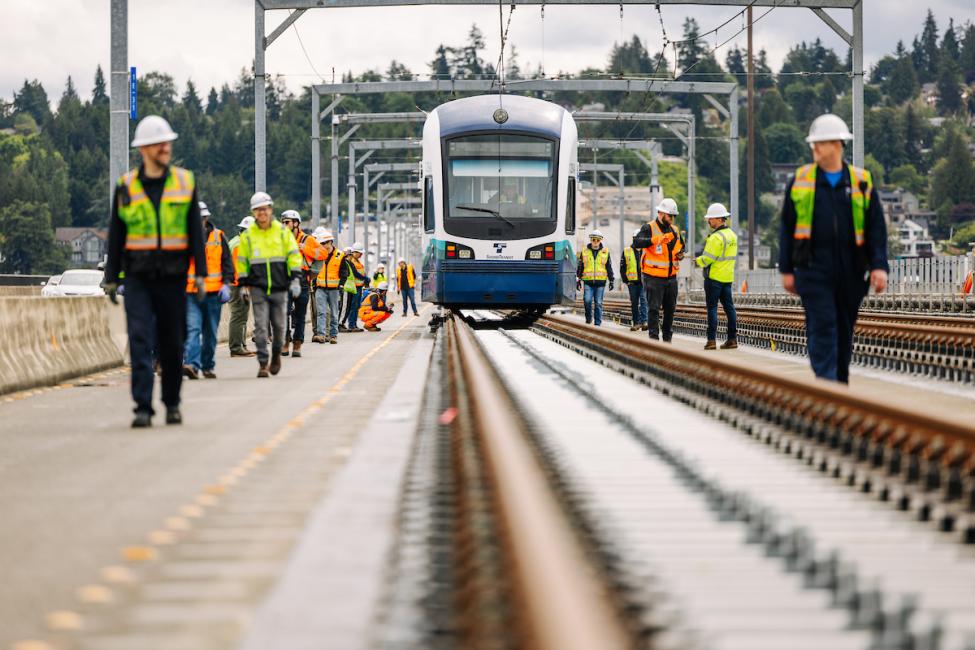In our May blog on the 2 Line’s Crosslake Connection across Lake Washington, we shared an update on remaining construction activities and video of a thrilling testing milestone: the first light rail train in the world to cross a floating bridge.
During this initial test, we used a specially equipped truck to push and pull an unpowered Link train across the Homer M. Hadley Memorial Bridge between Mercer Island and Seattle, testing clearance and bridge flexion.
The unpowered tow test was a resounding success, and engineers were pleased with the results, which are helping us prepare for the next step: testing vehicles under their own power this summer.
In the meantime, we’ve also been continuing work elsewhere on the system to help us prepare to open the 7-mile Crosslake Connection.
That’s meant some planned weekend closures on the 1 Line to accommodate testing. We’re grateful to our passengers for enduring these disruptions with patience, understanding, and a sense of excitement for more service coming soon!
Here’s what we’ve been working on in recent weeks.
Transfer trip testing
While “transfer trip” may sound like it involves passengers changing trains, it’s actually a highly technical electrical safety function.
Link light rail runs on electric power, served by small substations located every few miles along the tracks. These substations convert the local utility provider’s electricity and send it through the overhead wires that power the trains.
Our system is designed with overlapping substation power so that if the power supply to one or some is interrupted, others can fill the gap so that trains continue to move safely. At the same time, if one substation detects a fault and turns off power, the adjacent substation will do the same using the “transfer trip” function. This helps protect the rail network from power faults.
As Link service lines keep growing (and connecting, in the case of the 1 Line and 2 Line), we need to ensure all these power sources support one another as they should.
To confirm that this power system function works correctly, our crews needed access to the tracks for a span of several hours with the power on, but without any trains — which is why we suspended service the first weekend in June between Capitol Hill and SODO to complete testing. This allowed workers to run simulations in the control rooms of the power substations themselves.
This weekend of testing was also a success. Just as intended, this stress-testing process helped our teams pinpoint a few areas for follow-up work, but the systems performed well overall.
Four-minute headway testing
In June we also reached another testing milestone in preparation for “interlining,” or adding future 2 Line trains into the current 1 Line: running trains every four minutes.
Four-minute headways will constitute a doubling of service between International District/Chinatown and Lynnwood City Center stations, which currently runs every eight minutes in peak hours. But we want to ensure we can reliably provide this frequency before building it into our future service plans and schedules.
Over four hours beginning early Friday morning, June 13, we conducted our first test of four-minute headways, with 12 single-car trains slotted in between regularly scheduled 1 Line trains traveling between the Lynnwood terminus and Stadium Station.
While the trains didn’t carry passengers in this initial test, they simulated all station stops, pausing for 20 seconds at each platform. This allowed them to operate in between passenger trains and gave teams the ability to observe in real time what future peak service will look like.
This initial frequency test was a big success, featuring the safe operation of more trains than had ever before appeared on the alignment, and allowing us to gather lots of data to analyze before our next headway test — potentially with passengers aboard — later this summer.
What’s next?
Perhaps the most anticipated next step on the road to Crosslake will be trains operating under their own power, known as live wire testing.
Live wire testing, which will be both a key milestone and important data-gathering opportunity, is scheduled to begin this month. As testing continues throughout the summer, we’ll know much more and be better able to begin homing in on an opening timeframe.
We can’t wait to welcome you aboard, and we know the region is hungry for news on progress. Be sure to subscribe for monthly updates from The Platform blog and follow Sound Transit on Instagram so you never miss a Crosslake Update!
